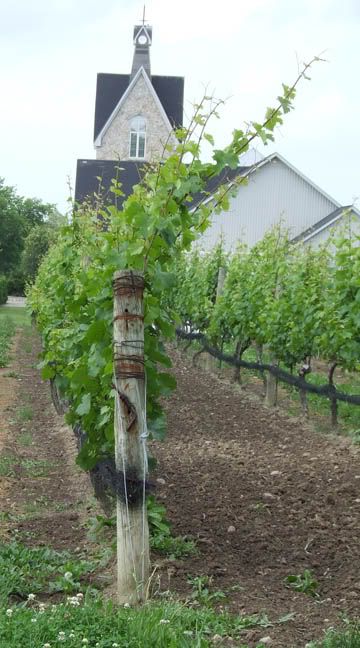Good Things Come to Those Who Wait:
My Wine's First Ticket
It's our first opportunity to make a decision for My Wine, My Way. We're being asked to crop thin now or in August. If we crop thin now it should increase the possibility of more uniformly ripe grapes come harvest time. So if we want to help our chances of making the best possible wine this year it's really a no-brainer decision. Time to get in the vineyard with the shears and get cutting—not so fast.
Coincidentally I've been taking a general viticulture course this summer and the one thing that's stuck above everything else is the underlying theme that it isn't easy or straightforward growing wine grapes in Niagara. Without getting into too much detail, Niagara has a short, humid, wet (especially at harvest) growing season followed by a harsh winter for a grape growing region. So what does this mean for Vitis vinifera, a plant of desert origins? It means certain varieties can be a struggle to ripen fully here. With little to no tricks or intervention cool climate varieties like Riesling need about 1700 growing degree days to fully ripen. Moderate climate Cabernet Sauvignon requires 1900 and the heat loving Grenache demands 2100. Niagara's weather fluctuates yearly affecting the quality of the growing season but it's a cool climate growing region, which is generally considered to be in the range of 1500-1700 growing degree days. The growing conditions in Niagara also mean grapes are susceptible to potentially crop-ruining fungal diseases and the grapes can become water logged or even burst when nearing harvest time. About 550 mm – 850 mm of precipitation per year is ideal for most Vitis vinifera. Niagara usually hits that target before the end of summer and exceeds it by year's end. If the grapes mange to get through all of that unscathed there's still the potential of vine-killing cold and frost severely damaging the buds in spring. Anywhere with winters below -23°C more than once every 20 years is considered unprofitable for viticulture—completely replanting can put you out of production for 3-5 years. Ideally the coldest winter month should average above -1°C. Plus most Vitis vinifera will die if the temperature falls below -15°C to -25°C (depending on the cold hardiness of the variety and clone). Niagara fails everyone of those criteria. It kind makes me glad that the vines our only our's until the Riesling gets made for the My Wine, My Way project.

So what does all this have to do with the decision to crop thin now or in August? As the My Wine, My Wine site explains, if we crop thin now we essentially lighten the vines' loads. The remaining grapes have to fight less for their share of sun, nutrients and other resources—thus more even ripeness. But unfortunately it's not just the grapes that get more of that good stuff. By lightening the load the canes stretch, grower thicker and you don't make wine out of canes. Unfortunately, these suddenly thicker canes have a tougher time getting ready for winter. As you know from the above anything we can do to help the vines prepare for winter is a good first step towards making a great wine next year.
Also if we crop thin now and (knock on wood) something should happen that puts the vines at risk, it would make it very difficult to produce a good wine in decent quantities. Even though the season started off warmer and earlier than usual, the recent moisture and humidity can be dangerous to this year's young grapes. In fact, just the other day there was a risk of severe thunderstorms and hail. I don't know about you but the risks outweigh the potential reward of grapes at harvest that are slightly more ripe vine-to-vine. Besides I'm sure there are some other upcoming wine making decisions that will allow us to help aid the potential ripeness of the grapes without risking next year's crop.

No comments:
Post a Comment